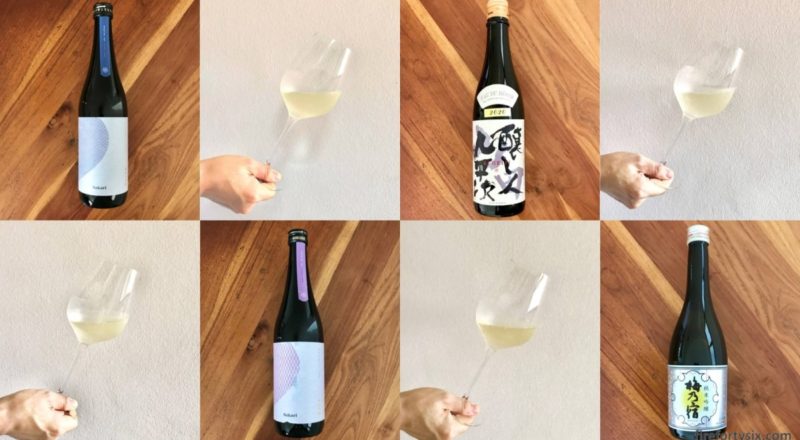More than a month has passed since we embarked on our search for smooth sakes available for sale in Singapore. Our orders from various online stores arrived progressively, and we’ve been keeping ourselves pleasantly intoxicated over the past few weekends.
I had conservatively chosen two junmai ginjos and two junmai daiginjos from three different breweries, with the assumption that the “pure rice” and high milling rates would result in pleasant and easy drinking nihonshu.
Umenoyado Junmai Ginjo (梅乃宿 純米吟醸)
The first bottle that we opened was the Umenoyado Junmai Ginjo (梅乃宿 純米吟醸), made by the same brewery in Nara that produces our favourite yuzushu.




It was sweet on the first sip with a nice umami aftertaste and while it tasted smooth, it wasn’t super smooth. There was a light floral scent and detectable undernotes of honey.
We paired it with some strong tasting and spicy food like ayam lemak chilli api, orh jian and Hokkien mee (with chilli) and it started tasting sharp and became slightly unpleasant. It definitely doesn’t go well with spicy Asian dishes.
However, we tried again with some sweet bak kwa and pineapple jam biscuits and the pleasant taste returned. Overall, we were quite happy with the bottle and would consider buying it again.
Sakari Junmai Ginjo (Sakari 純米吟醸)
The following weekend, we opened the Sakari Junmai Ginjo (Sakari 純米吟醸), which had a modern label design with minimal information.




Compared to the Umenoyado, it didn’t taste sweet and was closer to a medium dry. It was light tasting with a quick finish and didn’t linger in the mouth. The notes were more floral than fruity and it wasn’t particularly smooth.
We had it with teriyaki salmon, samgaetang and Popeye’s fried chicken. It paired quite well with the first two dishes, but not with the Popeye’s, probably because we ordered the spicy version. This was a bottle that we probably wouldn’t order again.
Sakari Junmai Daiginjo (Sakari 純米大吟醸)
The third bottle we opened was the Sakari Junmai Daiginjo (Sakari 純米大吟醸), which we bought as a bundle deal with the earlier Sakari.




Given our not-so-great experience with the junmai ginjo, we didn’t have high expectations. But it was surprisingly smooth and very palatable — sweet with floral notes and not too rich.
The Wife made a rice bowl with a vegetable, mushroom and pork stir-fry and it started tasting spicy. The following day, we ordered some Thai food and contrary to our expectations, it went quite well with red curry pork, maybe because it was creamy and medium spicy.
We still had some leftover bak kwa, and similar to the Umenoyado, the sweetness of the dried pork and sake complemented each other. Compared to the earlier two bottles of junmai ginjo, this Sakari junmai daiginjo definitely rated higher.
Kamoshibito Kuheiji “Eau du Désir” Junmai Daiginjo (醸し人 九平次 純米大吟醸)
I had high expectations for the Kamoshibito Kuheiji “Eau du Désir” Junmai Daiginjo (醸し人 九平次 純米大吟醸) because I had tried it before in Tokyo, and was surprised that it was available for sale in Singapore.




The cap was different from the other bottles and was a bit difficult to open, and once opened, it wasn’t easy to re-seal it fully. I would have preferred a normal screw cap, but perhaps there was a good reason for choosing this sealing method.
It was slightly sparkling and opened with a small pop. The scent and taste were both delicate and fruity, and it was definitely smooth tasting and easy to drink. We could see ourselves drinking this daily, if we actually drank daily, which we don’t.
This time we had it with some burgers, specifically a beef burger and a fried chicken burger, with a side of onion rings. It was nice with the chicken burger and onion rings, but not so good with the beef burger.
Among the four sakes, the Kuheiji was easily our favourite. We would consider getting the Sakari junmai daiginjo and Umenoyado again, but would skip the Sakari junmai ginjo.
Here’s a table with our ranking, together with the respective Sake Meter Value (SMV), Acidity (where available) and the price that we paid.
| Rank | Sake | SMV | Acidity | Price |
|---|---|---|---|---|
| 1 | Kuheiji Junmai Daiginjo | + 0 | 1.7 | S$73.00 |
| 2 | Sakari Junmai Daiginjo | − 6 | n.a. | S$57.50 |
| 3 | Umenoyado Junmai Ginjo | + 3 | 1.6 | S$45.00 |
| 4 | Sakari Junmai Ginjo | + 3 | n.a. | S$47.75 |
Not surprisingly, we preferred the two daiginjos over the ginjos and apparently, price was a good indicator of quality, at least for this small sample of four bottles.
In terms of food pairing, all of them didn’t fare too well with spicy Asian food, which I found slightly surprising, given how well sweeter wines go with spicy dishes. Perhaps drier sakes would do better? Something to put to the test in the future.
As we continue tasting more nihonshu from different breweries, our baseline for comparison will be the excellent Kuheiji junmai daiginjo. Hopefully we’ll be able to find bottles of similar smoothness and quality, and at similar prices of course.
Note: This post contains affiliate links. If you use these links to buy something, I may earn a commission. Thanks.
